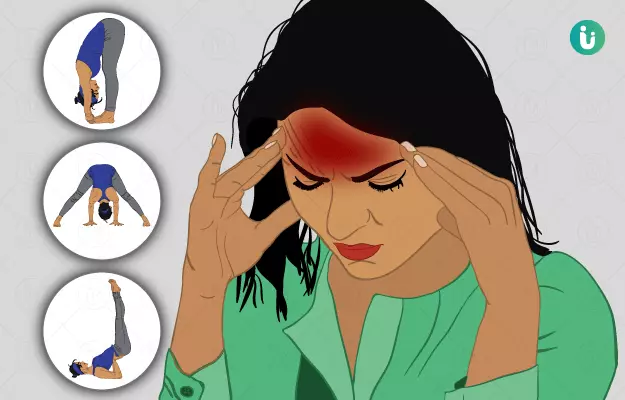When you have a headache, you are unable to concentrate on your other work and feel a lot of pain and heaviness in the head. At that time you think about how to get rid of the headache as soon as possible. Due to headache, there is also pressure and strain on the eyes, neck, shoulders and waist. Which is not good for your health.
To get rid of a headache, you quickly take medicine and these medicines are very harmful for your health. So from today stop taking medicine for headache and start doing yoga. Yoga will not only relieve your headache but will also keep you healthy.So, let us tell you some easy yoga exercises which are very beneficial in headache, but before that let us tell you how yoga is beneficial for headache -
(Read more -How to Combat Morning Headaches)
-
How Is Yoga Beneficial For Headaches?
- Benefits Of Padangusthasana Yogasana For Headache
- Benefits Of Ardha Pincha Mayurasana For Headache
- Benefits Of Prasarita Padottanasana For Headache
- Benefits Of Supta Veerasan For Headache
- Benefits Of Viparita Karani For Headache
- Benefits Of Paschimottanasana For Headache
- Benefits Of Ananda Balasana For Headache
- Benefits Of Shavasana For Headache
- Summary
How Is Yoga Beneficial For Headaches?
Yoga practice is considered to be a very good option to get rid of headaches. Yoga is so effective that with its help you get relief from headache as soon as possible. Yoga calms the mind and also increases blood circulation. This is a very good natural remedy for headaches. When headache is caused by strain in the shoulders, neck and waist, yoga stretches these organs and opens the blocks. Along with this, yoga increases blood flow and delivers oxygen to the head properly.
Yoga brings peace to your body, which becomes disturbed due to worries and stress. Once your body is relaxed, your headache will also disappear easily. Yoga ensures that there is adequate circulation of blood and oxygen to your brain. Yoga causes blood flow towards the brain and it is very useful for your body.
(Read more - Home remedies for headache relief)
Benefits Of Padangusthasana Yogasana For Headache
Padangusthasana is a very common yoga asana. In this, you have to bend forward, in which you will hold the toes of the feet with your hands. When you bend forward, the blood will reach your head well, so that there will be no reduction in circulation and oxygen flow. In this way your headache will be cured quickly.
Level - Normal
How long to do - 30 seconds
How to do Padangusthasana -
- Before starting this asana, you first have to stand straight and keep both feet equal to each other. Your feet should be at least 6 inches away from each other and the legs should be straight.
- Now bend a little, try that your forehead touches the knees. Also keep in mind that both your torso and head work together.
- Now hold the toes of your feet with the fingers of your hands.
- Now breathe in and keep the torso in this position. Keep in mind that your knees should be straight.
- Now exhale. Similarly, try to do this process several times. Then stand up straight.
(Read more - First aid for headache)
Caution -
This is a common yoga position, which anyone can do. But, make sure that you practice it under a trainer only. Also, if you have a problem of neck pain or back injury, then do not do this asana.
See Similar Category Medicines Here
Benefits Of Ardha Pincha Mayurasana For Headache
Ardha Pincha Mayurasana is a little similar to Adho Mukha Svanasana (you can also do this asana to get rid of headache), in this the weight of the whole body is kept on the elbows instead of the palms. This asana gives a good stretch to your neck and waist and increases blood flow to the brain.
Level - Normal
How long to do - 30 to 60 seconds
How to do Ardha Pincha Mayurasana -
- First of all, sit on your knees.
- Now keep your hands on the ground. Keep in mind that your hands and shoulders should be in a straight line.
- Now lift your waist and hips upwards and keep the legs straight. As shown in the picture.
- Then keep your head between your hands.
- Maintain this position for a few seconds and keep breathing deeply.
Caution – If you have a neck or shoulder injury, do not do this asana. While practicing this asan, you can bend your knees in this asana.
(Read more – Gastric Headache)
Benefits Of Prasarita Padottanasana For Headache
This asana is also a forward bending asana. A bit like Padangusthasana or Uttanasana (this also helps in curing headaches). The pose of this asana bends your stomach area, which helps in good blood flow to your waist, neck, shoulders and head. This gives you relief from headache very soon.
Level - Normal
How long to do - 30 to 60 seconds
How to do Prasarita Padottanasana -
- Before starting this asana, first stand in Tadasana.
- Now inhale and spread your legs three to four feet. Now keep your hands on your waist and keep in mind that the heels of both your feet should be equal.
- Now slowly bend your torso downwards.
- Then exhale and slowly move your hips upwards.
- Now place your hands on the ground and raise your hips as per your capacity.
- Now take your hands to your hips and slowly straighten your torso and then come to the state of Tadasana.
Caution - If you have back pain or any injury, then do not do this asana at all. Also, if you have sinus problems, then also do not do this asana.
(Read more -Pain in the Back of Your Head)
See Similar Category Medicines Here
Benefits Of Supta Veerasan For Headache
When a headache is related to stress, then you should stretch your waist and shoulders, which reduces stress completely. This asana frees you from stress and by getting stress free, your headache also disappears.
Level - Medium
How long to do - 30 to 60 seconds
How to do Supta Veerasana -
- First of all, sit on your knees.
- Now lie down while bending the torso backwards. But do not lie down completely, keep the waist slightly raised. (As per the picture)
- You can either keep your hands on your side or take them backwards.
- Keep breathing slowly and then come back to the old state after some time.
Caution -
If you have problems with your waist, ankles or knees, then do not do this asana. It would be better if you do this asana with the help of a trainer.
(Read more -Vascular Headaches)
Benefits Of Viparita Karani For Headache
This asana will seem a little difficult, but it is equally beneficial. This asana relaxes your entire body and mind. You will just need a wall in this asana. In this way your headache will go away instantly.
Level - Normal
How long to do - 5 to 15 minutes
How to do Viparita Karani -
- First of all, exhale and lie down with your feet facing the wall.
- Place your feet on the wall and keep the soles upwards.
- Keep in mind that your hips should be slightly away from the wall.
- Keep your waist and hips comfortably on the ground.
- Now raise your hips upwards. You can also lift your hips with the help of your hands.
- Maintain this position for five minutes. Then come back to the old position.
(Read more - Home remedies for migraines)
Caution -
Benefits Of Paschimottanasana For Headache
Paschimottanasana is considered to be a very good asana. This asana helps in relieving headache. This asana keeps the brain calm and frees the person from stress. Now whenever you have a headache, definitely adopt this asana.
Level - Normal
For how long - 30 to 60 seconds
How to do Paschimottanasana -
- First of all sit with legs straight in front.
- Now inhale and take the hands upwards.
- Then exhale and bend forward.
- Now hold the toes of the feet with your hands and feel a stretch.
- Then maintain this position for a few minutes and then return to the previous position.
(Read more - The Link Between Stress and Migraines)
Caution -
Benefits Of Ananda Balasana For Headache
If you are having a headache due to back pain, then lie down and rest. This asana will help in relaxing your body and mind.
Level - Normal
For how long - 30 seconds
How to do Ananda Balasana -
- First of all, lie down straight.
- Then lift the legs straight upwards and then bring them towards the chest.
- Now open the legs so that it is easy for you to hold the toes with your hands.
- Then hold the toes of the feet with the hands.
- Keep this position like this for a few minutes and then come back to the old position.
Precaution -
- If you are suffering from neck injury, then during this asana you can put a thin blanket under the head.
- Also keep in mind that your waist should remain straight during this asana, so that you do not get hurt in any way.
- Pregnant women and those who are suffering from periods should not do this asana.
- People who are suffering from high blood pressure or knee injury should also not do this asana.
(Read more - Melatonin Therapy for Migraines)
See Similar Category Medicines Here
Benefits Of Shavasana For Headache
Shavasana is a completely relaxing asana, which helps in giving quick relief to your body. Shavasana is considered a very good option, whether it is stress, pain or any other problem. Next time whenever you have a headache, definitely adopt this asana.
Level - Normal
How long to do - 10 to 12 minutes
How to do Shavasana -
- First of all, lie down straight. But, keep in mind that there should not be any kind of disturbance around you. Apart from this, do not use any pillow. Do this asana only on a hard floor.
- Now close your eyes.
- Relax your feet and keep the toes upwards.
- Then keep your hands on the side and keep the palms upwards.
- Then inhale and exhale slowly and after closing your eyes, concentrate on every part of your body. Start with the feet.
- Gradually finish the process of concentrating on the head.
- When your body starts feeling completely relaxed, keep the eyes closed and rest for some time.
(Read more - Headache during pregnancy)
Summary
Headaches are a common health problem, which can occur due to various reasons. Its main types include tension headaches, migraines, and sinus headaches. Tension headaches are usually caused by tension in the muscles of the head and neck, while migraines are often associated with neurological and hormonal changes. Sinus headaches are caused by sinus infections or allergies. Rest, drinking enough water, and painkillers can be used to relieve headaches. In some cases, lifestyle changes, such as regular exercise, a healthy diet, and stress management techniques, can help reduce headaches. If headaches occur frequently or are severe, it is necessary to consult a doctor so that proper diagnosis and treatment can be done.













